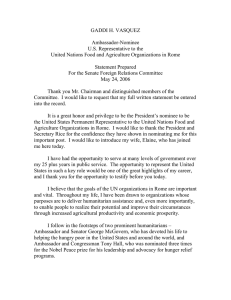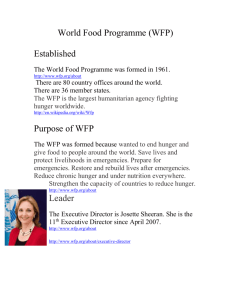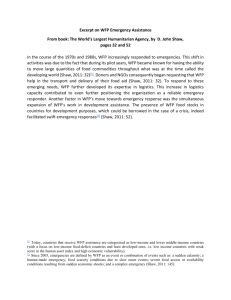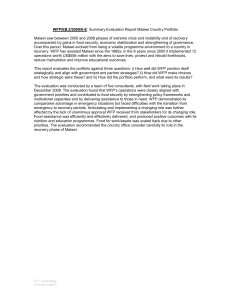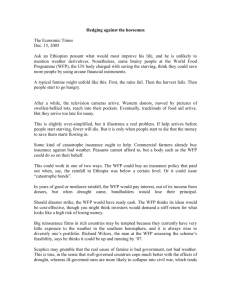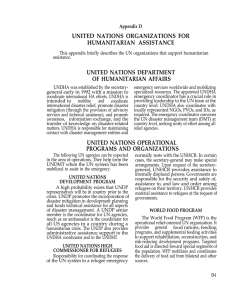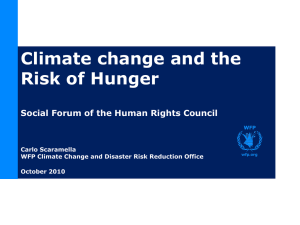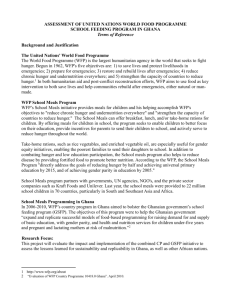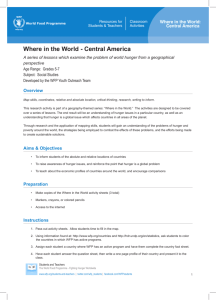Challenges in deploying telecommunications / ICT for disaster response (GET2016)
advertisement
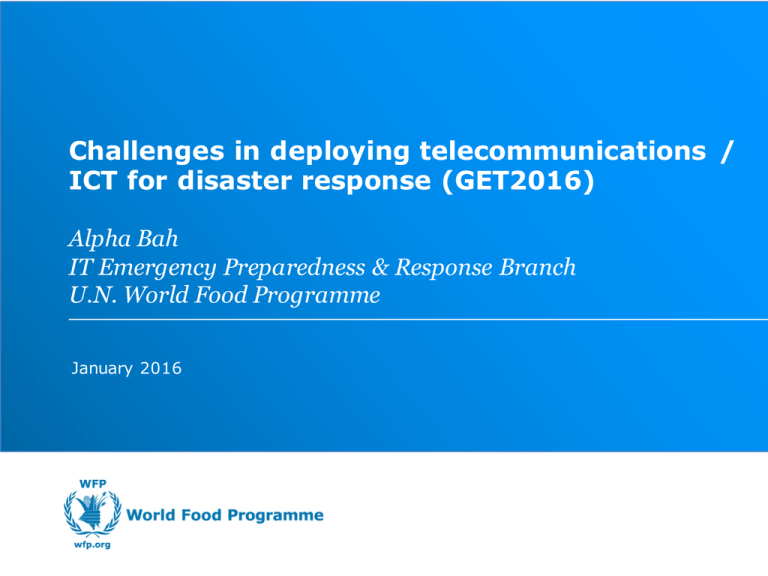
Challenges in deploying telecommunications / ICT for disaster response (GET2016) Alpha Bah IT Emergency Preparedness & Response Branch U.N. World Food Programme January 2016 When disaster strikes… … timely provision of ICT services saves lives 15 | World Food Programme WFP – 5 key facts 1. The World Food Programme is a UN agency whose mission is to end global hunger. 2. We are 100% voluntarily funded by governments, the private sector and individuals. 3. We partner with national governments, non-governmental organizations (NGOs), institutions, corporations and others. 4. On average, we reach more than 80 million people with food assistance in 75 countries each year. 5. About 14,000 people work for WFP, most of them in remote areas, directly serving the hungry poor. 2 | World Food Programme The Zero Hunger Challenge is the UN SecretaryGeneral’s call to the world to end hunger in our lifetimes. WFP’s entire strategy is aimed at helping the world achieve that goal. WFP’s Global Presence 7 | World Food Programme What We Do Prepare for and respond to emergencies 10 | World Food Programme Help make communities stronger, better able to deal with climate shocks Enable people and countries to meet their own nutrition needs Improve mother and child nutrition We respond to humanitarian emergencies Whether refugees are fleeing war, floods are washing away homes or drought is destroying farmland, hunger is often the first emergency. Time saved means lives saved. WFP, with its global presence and logistics muscle, is ready to respond within hours. Being prepared is part of the secret. WFP is constantly collecting and analysing information on natural and man-made hazards. If we can see that an emergency is looming, we can lessen its impact. Extra supplies can be positioned in convenient locations. 11 | World Food Programme We put our logistics capability at service of humanitarian community • We manage the United Nations Humanitarian Air Service (UNHAS): In 2013, WFP flew more than 364,000 humanitarian workers and nearly 2,000 tons of cargo to 237 places. • We manage the UN’s humanitarian warehouse hubs (United Nations Humanitarian Response Depots) in six strategic locations around the world. In 2013, we dispatched US$35 million in relief supplies. • We provide Logistics Services directly to the humanitarian community, e.g. we built Ebola Treatment Units for the World Health Organization in West Africa. • We coordinate logistics operations for the humanitarian community in major emergencies. 15 | World Food Programme We support the humanitarian community In emergencies, WFP is the lead coordinator (“cluster leader” ) for the humanitarian community in: • Logistics • Emergency telecoms • Food Security:shared the leadership role with the Food and Agriculture Organization of the United Nations (FAO) We ensure services are in place and information is shared. 18 | World Food Programme The IASC Clusters 15 | World Food Programme Emergency Telecommunication Cluster (ETC) : A Global Network Aglobalnetworkoforganisations that worktogethertoprovide sharedcommunications services inhumanitarianemergencies. WFP is global lead of the ETC w w w . E T Cl ust er . or g ETC: Emergency Response Operations Overview (2015) Syria Iraq Nepal West Africa Yemen Vanuatu South Sudan Central African Republic w w w . E T Cl ust er . or g Larger Scope – ETC2020 Strategy AffectedPopulations Government ResponseCommunity Photos: Oxfam/SimonRawles; WFP/ Mariko Hall; TelecomsSansFrontieres w w w . E T Cl ust er . or g WFP IT and ETC Building preparedness before an emergency strikes As Global ETC Lead, WFP leverages its in-country IT capacity and networks to establish IT emergency preparedness and build resilience. Working together during an emergency response When nominated as local ETC lead, WFP uses its in-country IT capacity and emergency response team (FITTEST), NGOs, standby and private sector partners, to deliver shared communications services to the response community. Learning and developing after an emergency After demobilization of the ETC, WFP IT builds upon new connections and continues building capacity, learning from the emergency and preparing for the next. 15 | World Food Programme FITTEST FITTEST WFP’s IT response capacity Operational Challenges 1.Regulatory: Restrictions on import, clearance, licensing, and physical access 2.Duplication: multiple assessments, duplication of services 3.Coordination: Complexity of coordination mechanism (too many coordinators), multiple contacts 4.Surge capacity: Several protracted emergencies stretching limited resources 5.Leveraging evolving technologies & partner solutions: identifying “fit for purpose” solutions (too many solutions looking for problems) 6.Financing: Lack of donor interest in ICT, especially on preparedness 15 | World Food Programme The way forward for emergency telecoms 1.Working closer with governments in high-risk countries to build communication resilience: joint capacity building activities, developing SOPs for EPR, leveraging strength of parties. 2.Improved and decentralized preparedness: local pre-positioning, joint simulation exercises involving local service providers. 3.Increased private partnerships: private companies as partners rather than service providers, actively involved by sharing their expertise. 15 | World Food Programme World Food Programme Information Technology Division January 2016
